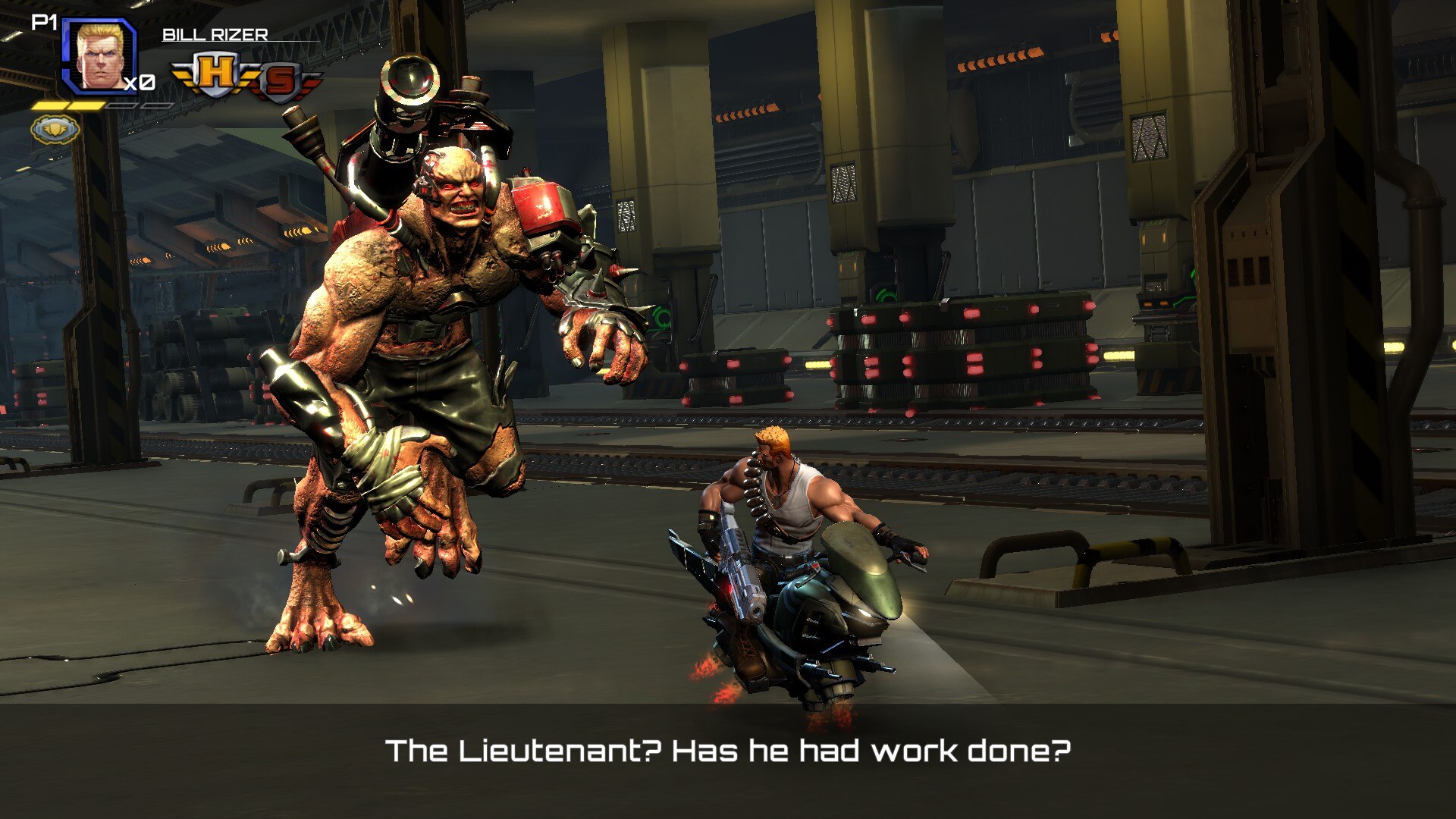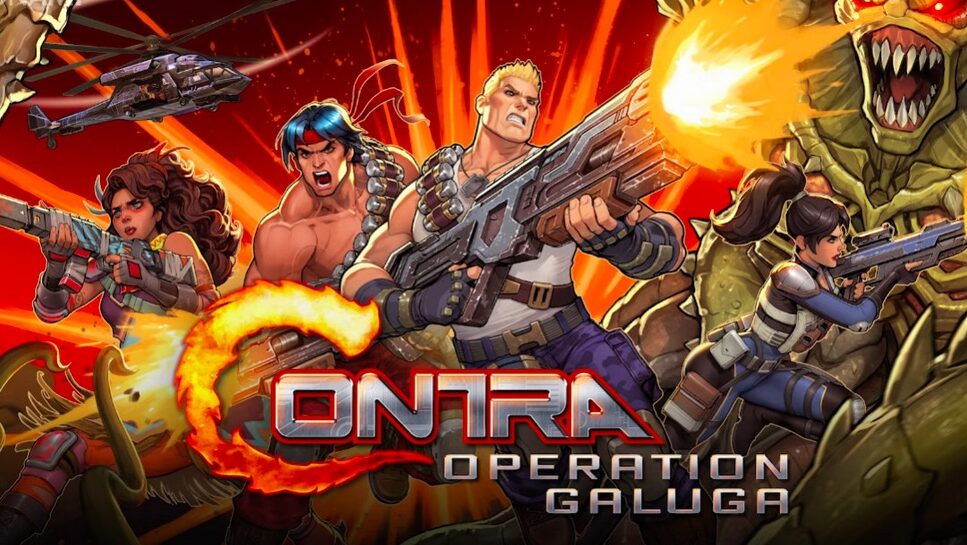WayForward made Contra 4 on the Nintendo DS, a solid entry in the franchise that also made full use of the two-screen hardware. This was back in 2007, and since then, Contra has been in limbo. There was Contra ReBirth, which has become lost due to the Wii eShop closure. Hard Corp: Uprising embraced Guilty Gear-like anime art and offered beefy replayability, but is relegated to digital marketplaces on PlayStation 3 and Xbox 360.
Then there was Contra: Rogue Corps; a concept that had potential but was wasted due to tedious repetition, repetitive loot mechanics, and 30 fps parity across all versions. While fans of this venerable run-and-gun series could always replay the classics with the Contra Anniversary Collection, it seemed like forever since the world had a proper Contra experience with big guys doing huge flips and shooting big guns in 2D.
With WayForward back in command, it would appear that gamers could rejoice, right? It has been a long time since Contra 4, and WayForward isn’t the same company they were in 2007. Can they still deliver the same alien-blasting, spread-gunning, and missile-riding action? Find out in this Contra: Operation Galuga review!
Contra: Operation Galuga
Developer: WayForward
Publisher: Konami
Platforms: Windows PC, Nintendo Switch, Xbox One, Xbox Series X|S, PlayStation 4, PlayStation 5 (reviewed)
Release Date: March 12, 2024
Players: 1-4
Price: $39.99 USD

Contra: Operation Galuga is alarmingly bare-bones at the start. The developers’ attempt at a story mode is appreciated, but their efforts feel half-hearted. The story is generic, and the tone feels like a cheap knock-off of G.I. Joe rather than anything the franchise has had before. Classic Contra drew a lot of inspiration from hardcore R-rated action movies from the 80s, like The Predator, Aliens, First Blood, and The Terminator.
These films heavily influenced the tone and visual style of the original games. Operation Galuga, however, resembles a cheap mobile game where the characters look like Playskool versions of Contra staples. When squinting, some of the bosses and characters vaguely resemble the H.R. Giger-inspired designs, but now with soft and round features, seemingly designed for children who love Marvel films.
The lighting on many objects is very flat or nonexistent. There is no bounce light or atmospheric effects and stone textures look like its made of plastic. Models lack weight and the foliage is unconvincing. The visual design looks cheap like everything was created for efficiency rather than aesthetics.

The cutscenes have amateurish portraits that would look passable for a high school student but are embarrassing for a studio that has been around for decades. The line work is sloppy, there is no animation, and there is no style at all. These 2D assets look like something that was intended to be a placeholder rather than the finished product. The presentation is hopelessly cheap.
The script is painfully generic. It’s written in a very predictable style where it’s easy to anticipate every line. The voice acting doesn’t help either. At first, it’s easy to assume Bill Rizer’s voice actor is trying to sound like Steve Blum, but it actually is Steve Blum. The actor seems utterly disinterested in the material, delivering a phoned-in performance that sounds like a pale imitation of himself.
The story also ends on a cliffhanger that promises to reimagine Contra III: The Alien Wars. Operation Galuga is so short, that it feels like half of a game for its price, by the time it ends it should be the halfway point. This was a missed opportunity to have the 2nd half of the game only accessible for playing on Normal Mode or above, like how it used to be.

Even if fans choose to ignore the lame story and focus on the reliable arcade mode, the subpar graphics will persist. Metroid Dread shows how excellent a gritty 2.5D run-and-gun action game can look, but Operation Galuga ends up miles behind. There’s no grit or artistry, lacking detail with rough and ugly textures.
Animations are also stiff, which is surprising since WayForward usually puts a lot of care into the animations in their Shantae titles. In most regards, Contra: Rogue Corps ends up looking better, which is sad because that was a rugged-looking game itself. It got by because it had distinct and memorable character designs and a gnarly, grungy punk atmosphere.
In a surprising misstep, WayForward miscalculated the mechanics of what makes a good run-and-gun shooter. Usually, games like this use a 4:3 aspect ratio to ensure incoming foes have a chance to attack players. When switching to 16:9, the extra screen space gives gamers a vast view of what’s coming. This trivializes a great deal of the challenge, and there was no thought to at least design the characters to be wider or the bullets bigger to consider the increased space.

Most of the level design borrows from hits from past Contra games. Operation Galuga barely does anything original and most of the game feels like nostalgic pandering. This new entry fails to offer anything new apart from the admittedly large character roster.
Other balancing aspects, particularly weapons, were overlooked. On harder difficulties, homing rockets become excessively effective. Cautious maneuvering becomes unnecessary as the rockets clear almost any enemy encounter. Prior Contra titles with homing rockets emphasized boss battles where dodging was crucial.
Getting the homing rockets early on will carry you most of the way through the game. When there are areas with respawning enemies, getting free lives becomes a matter of standing in one place and letting the rockets do their thing. There is no time limit either, so it’s possible to do this till doomsday.

In Operation Galuga‘s standard action-platforming stages, homing rockets trivialize enemy placement and challenge. Their constant availability and upgrade options through perks further exacerbate the issue. Some perk combinations can create game-breaking immortality. Abilities that restore health by sacrificing power-ups are overpowered since power-ups are abundant. Bosses die in seconds when using the powered-up rockets too.
The cooldown for summoning a power-up practically guarantees indefinite survival. Traditionally, Contra games are brutally intense. Operation Galuga‘s surprising ease is disappointing. The hardest difficulty lacks exclusive bosses or a true final boss, unlike Contra III: The Alien Wars. Operation Galuga offers a minimal incentive for playing on harder modes by giving everything away on all difficulties.
The core mechanics also feel sluggish. The inputs have a noticeable delay, proving to be the biggest hurdle in the entire game. Whether jumping, dashing, or ducking, expect a slight delay before the animation follows through. This makes the controls feel sticky and imprecise.

While some players might adapt to this, the frequent and long load times are universally frustrating. This could be a result of using the Unity Engine, which can sometimes struggle on Nintendo Switch hardware. On more powerful systems, it may not be an issue. These long load times make replaying the game less enjoyable and more tedious.
When playing on PlayStation 5, most of these technical issues are circumvented. The gameplay feels more fluid and snappy. However, even on the PlayStation 5, this short game, designed for the less powerful Nintendo Switch, still crashes unexpectedly.
Like past entries, this is a short game with high replay value. Operation Galuga goes further than most to keep things fresh. This entry boasts the most playable characters of any Contra game before it. WayForward put in the effort to make them play slightly differently and each has a unique perk to unlock.

The post-game unlockable characters require an unusually large amount of currency. While they are worth the effort to obtain, the process is quite tiresome. Expect to replay the story or arcade mode a significant number of times to unlock them all. By this point, the game long overstays its welcome and you’ll be sick of looking at it.
Operation Galuga commits a heinous crime by locking out the hardest mode behind an absurd unlockable cost. By the time it takes to earn the amount of points to buy the hardest difficulty, you can expect to have played through the game at least ten times minimum. Operation Galuga isn’t good enough to warrant that many play-throughs and this kind of feature should have been available at the start. WayForward truly scrapped what they could to artificially extend the playtime.

Players expecting a classic run-and-gun experience in Contra: Operation Galuga might be disappointed by the repulsive mobile-like graphics, but those seeking mindless fun will find a few hours of amusement. Unpolished controls and excessive load times on Nintendo Switch further hinder the experience. The experience fares better on PlayStation 5, but it will still be setback by system crashes.
This is a very mediocre shooter that plays it too safe and lacks the charm of the originals. There are far better options out there like Blazing Chrome or Gunlord X that will scratch that itch far better and those are priced more fairly than Contra: Operation Galuga.
Contra: Operation Galuga was reviewed on PlayStation 5 using a copy purchased by Niche Gamer. You can find additional information about Niche Gamer’s review/ethics policy here. Contra: Operation Galuga is now available for Windows PC (via Steam), Xbox One, Xbox Series X|S, PlayStation 4, PlayStation 5, and Nintendo Switch


